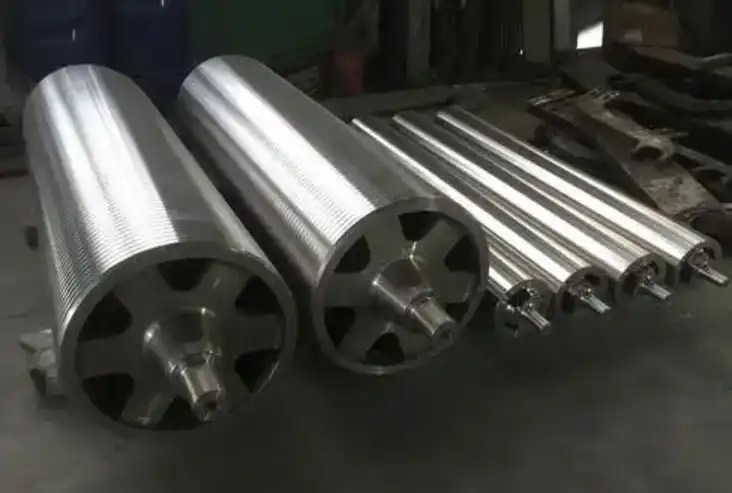Understanding Stabilizer Roll Lubrication Requirements
Factors Influencing Lubrication Needs
The lubrication requirements of stabilizer rolls are influenced by various factors, including operational conditions, environmental factors, and roll design. High-temperature environments, for instance, necessitate lubricants with excellent thermal stability. Similarly, rolls exposed to corrosive substances require lubricants with enhanced rust and oxidation protection. The speed and load characteristics of the stabilizer rolls also play a significant role in determining the optimal lubricant viscosity and additives required for effective performance.
Common Lubrication Challenges
Stabilizer rolls often face lubrication challenges such as contamination from process materials, water ingress, and high-temperature degradation of lubricants. These issues can lead to increased friction, accelerated wear, and potential equipment failure. Addressing these challenges requires a comprehensive approach that combines proper sealing mechanisms, contamination control measures, and the selection of lubricants specifically formulated to withstand harsh operating conditions.
Importance of Proper Lubrication
Proper lubrication is paramount for the optimal functioning of stabilizer rolls. It not only reduces friction and wear but also helps dissipate heat, prevent corrosion, and seal out contaminants. Effective lubrication strategies contribute to enhanced energy efficiency, extended equipment life, and reduced maintenance requirements. By maintaining a consistent lubricating film between moving surfaces, stabilizer rolls can operate smoothly and reliably, even under demanding conditions.
Advanced Lubrication Techniques for Stabilizer Rolls
Automated Lubrication Systems
Implementing automated lubrication systems represents a significant advancement in stabilizer roll maintenance. These systems ensure precise and timely delivery of lubricants to critical points, eliminating the inconsistencies associated with manual lubrication. By maintaining optimal lubricant levels and reducing the risk of over- or under-lubrication, automated systems contribute to improved equipment reliability and reduced downtime. Moreover, they minimize human error and exposure to potentially hazardous environments, enhancing workplace safety.
Synthetic Lubricant Formulations
The use of high-performance synthetic lubricants has revolutionized stabilizer roll lubrication. These advanced formulations offer superior thermal stability, oxidation resistance, and load-carrying capacity compared to conventional mineral oils. Synthetic lubricants can maintain their properties under extreme temperatures and pressures, providing extended service intervals and improved equipment protection. Their enhanced film strength and reduced friction characteristics contribute to energy savings and improved operational efficiency of stabilizer rolls across various industrial applications.
Condition-Based Monitoring
Adopting condition-based monitoring techniques allows for proactive maintenance of stabilizer roll lubrication systems. By utilizing sensors and analytics to monitor lubricant condition, temperature, and equipment vibration, operators can detect potential issues before they escalate into critical failures. This approach enables timely interventions, optimizes lubricant consumption, and prevents unnecessary maintenance activities. Condition-based monitoring not only enhances the reliability of stabilizer rolls but also contributes to significant cost savings through reduced downtime and improved resource allocation.
Implementing Effective Lubrication Strategies
Lubricant Selection Criteria
Choosing the right lubricant for stabilizer rolls requires careful consideration of several factors. Viscosity is a critical parameter that must match the operational speed and load of the rolls. Additionally, the lubricant's temperature range should align with the expected operating conditions. Additives play a crucial role in enhancing lubricant performance, providing features such as extreme pressure resistance, anti-wear properties, and corrosion protection. It's essential to select lubricants that comply with industry standards and manufacturer recommendations to ensure optimal performance and compatibility with stabilizer roll materials.
Application Methods and Best Practices
The effectiveness of a lubrication strategy largely depends on proper application methods. For stabilizer rolls, centralized lubrication systems offer significant advantages, ensuring consistent and accurate lubricant delivery to all critical points. Proper cleaning of lubrication points before application is crucial to prevent contaminant ingress. When manually applying lubricants, it's important to follow specified quantities and intervals to avoid over- or under-lubrication. Regular training of maintenance personnel on correct lubrication procedures and safety protocols is essential for implementing best practices effectively.
Maintenance and Monitoring Protocols
Establishing comprehensive maintenance and monitoring protocols is vital for the long-term success of stabilizer roll lubrication strategies. Regular inspections of lubrication systems, including checks for leaks, blockages, or wear, help prevent unexpected failures. Implementing a structured schedule for lubricant analysis provides valuable insights into lubricant condition and equipment health. This data-driven approach allows for timely adjustments to lubrication practices and helps optimize maintenance intervals. Additionally, maintaining detailed records of lubrication activities, including types of lubricants used, quantities, and dates of application, supports informed decision-making and continuous improvement of lubrication strategies.
In conclusion, implementing effective lubrication strategies for stabilizer rolls is essential for maximizing equipment performance, reliability, and longevity. By understanding specific lubrication requirements, adopting advanced techniques, and following best practices in application and maintenance, industries can significantly enhance the efficiency of their operations. For more information on stabilizer rolls and customized metal parts for various industries, including oil and gas, metallurgical, and mining machinery, please contact us at info@welongpost.com. Our team of experienced engineers and staff at China Welong are ready to assist you with your specific needs, ensuring high-quality products and optimal performance for your industrial applications.
References
- Automatic Lubrication Systems - SKF USA. (2025, February 12). SKF USA.
- Smart Manufacturing Technology Is Transforming Mass Production. IBM. (n.d.).
- Automatic Lubrication System: The Ultimate Guide 2024. Hymalube. (2024, November 15).
- Condition Monitoring: Guide to the 5 Major Technologies. Samotics. (2024, November 19).
- Lubrication Effects on the Surface Quality Control of Hot Rolled. ScienceDirect. (2024, November 1).
- High-Performance Lubricants Market Size, Growth & Forecast 2032. Credence Research. (2025, February 14).




